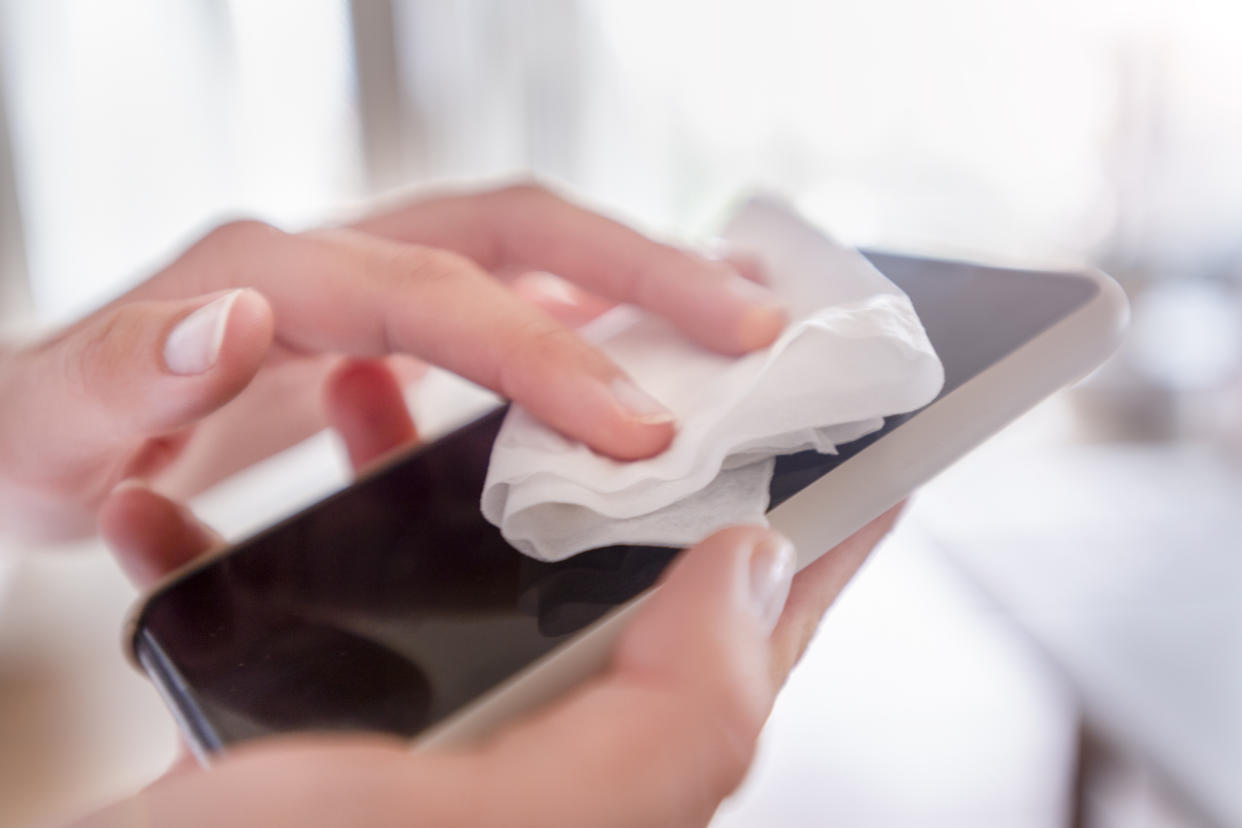Is your phone causing you acne?

There's no getting round it, we are a nation of mobile lovers. From endlessly scrolling social media to answering emails on the loo, heck we have even been known to sleep with our smart phones.
Of course there are a lot of advantages of having technology at our finger tips, but it's also important to recognise there can be some health impacts of being constantly glued to our digital friend.
And while we know about potential side effects such as eye strain, headaches and poor sleep we might not realise our mobiles can also be negatively impacting our skin.
Can mobile phones cause spots and acne?
In a word, yes! That's thanks to the amount of bacteria they pick up, with the average, smartphones harbouring ten times the amount of bacteria found on the average toilet seat. Grim.
The problem is when you hold your mobile to your ear to make a call, that bacteria is transferred to the skin on your face.
“Our phones are a big culprit at transferring bacteria to our faces," explains clinical facialist, Kate Kerr from Kate Kerr London.
“They are an essential part of our daily lives, but we expose them to millions of toxins, bacteria, and dirt throughout the day only to press them up against our face. This accumulation of germs will upset the barrier function, cause inflammation, and accelerate oil flow which can then result in acne.”

Kerr says heat is also activated by your phone, caused by holding it in your hand, up to your ear and onto your face.
"This will trigger your sebaceous glands, stimulating further oil production," she explains. "Finally, the HEV light that radiates from your phone can cause oxidation and inflammation on your skin, impairing the barrier and potentially leading to acne."
Thankfully, there are some simple steps you can take to side-step the skin blemishes caused by your phones.
How to prevent mobile phone-induced acne
Wipe it down
A recent study by MattressNextDay found that a bacteria, pseudomonas aeruginosa, commonly found in cockroaches and their faecal droppings was also found on our phones.
This bacterial pathogen can be particularly bad for people with a compromised immune system. It can also be a common cause of skin irritation.
The issue is we're not cleaning our phones nearly enough, or with the right products, with a further poll by the mattress specialists revealing that over half of us (51%) never use antibacterial products, while an additional 10% cleaned their phones just once a YEAR!
"But by incorporating simple hygiene practices, such as regularly cleaning your phone with antibacterial wipes, you can significantly reduce the risk of skin breakouts," Kerr says.

Wash your pillowcases and bedding more regularly
If you're one of the 74% of people take their phone to the bedroom at night, you might want to find an alternative place to keep it.
Not only can snuggling down with your mobile phone impact your sleep due to the blue light emitted tricking your brain into thinking it is time to wake, it could also be causing spots to breakout on your skin thanks to bacteria from your phone being transferred to your pillowcase and bedding.
"That bacteria can cause spots and clogged pores," warns Martin Seeley, CEO and sleep expert at MattressNextDay. "This can be even more evident if you then sleep on a pillowcase that has bacteria build-up due to your phone."
If you do sleep with your phone under your pillow, Seeley recommends washing your pillowcase twice a week.
"This ensures bacteria does not build up that can be passed to your skin, especially if you do not regularly clean your phone," he adds.
Use headphones
To prevent existing bacteria on your phone’s screen coming into contact with or sitting against your face during a call, a simple tip would be to use headphones.
You can also opt for a headset, speakerphone, or avoid the problem altogether by conducting all comms via Whatsapp.
If you can't resist the lure of a call in the old-fashioned ear to face way, try to reduce the skin-to-phone contact by holding it phone away from your face or just loosely against the skin to avoid putting unnecessary pressure on your skin.

Be proactive with products
If you've passed the preventative stage and are already suffering from a phone-induced spot breakout, there are some products you can try to treat the problem.
Hydrocolloid is key to gently drawing out infection. “Not all acne is equal" says Dr Sara Imani, doctor and skin expert at SkinChoice. “While there are various types of lesions, each requires a different approach to treatment,” she explains. “When it comes to those with visible pus such as whiteheads, papules and pustules, hydrocolloid is particularly effective for gently drawing out infection, reducing swelling and protecting the area from further irritation all while promoting healing.”
Try blemish patches to heal skin
Instead of popping or picking at pimples (and causing damage to skin in the process), Dr Imani suggests trying blemish patches. "They work by delivering a dose of hydrocolloid to the inflamed area, helping the spot to flatten and skin to heal," she adds.
LED is the blemish-busting solution to healing skin from the inside-out
Blue light has powerful anti-bacterial properties that decongest and purify acne and problem skin, while helping to normalise oil production.“For effective at-home acne treatment, LED is ideal,” Kerr adds.
Read more about skincare:
Doctor reveals the ‘5 K rule’ to follow for better skin and gut health (Yahoo Life UK, 3-min read)
Can sleeping on your back help prevent wrinkles? (Yahoo Life UK, 5-min read)
What is the ‘morning shed’ skincare routine and are there any benefits? (Yahoo Life UK, 6-min read)


